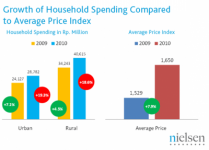Double-Digit Spending Gains Outpace Price Increases in Indonesia
Soon Lee Lim, Director of Consumer Panel Services, The Nielsen Company
 Inflation is becoming a critical issue in many parts of the world, but, especially in emerging markets such as Indonesia. But while prices rose 7.9 percent in 2010, household spending increased at an even faster rate – up 19.3 percent in major cities and 18.5 percent in rural Java – making the year a good one for manufacturers of Fast-Moving Consumer Goods (FMCG) in the country.
Inflation is becoming a critical issue in many parts of the world, but, especially in emerging markets such as Indonesia. But while prices rose 7.9 percent in 2010, household spending increased at an even faster rate – up 19.3 percent in major cities and 18.5 percent in rural Java – making the year a good one for manufacturers of Fast-Moving Consumer Goods (FMCG) in the country.
In major cities such as Jakarta, Bandung, Surabaya, Semarang and Medan, household spending was more than Rp. 3.7 million, up 33 percent from 2007, while in rural Java, spending was more than Rp. 2 million, an increase of 36 percent from 2007.
More Variety = More Spending
Manufacturers have spoiled consumers by offering new products and variants so that consumers can choose different products that are most suited to their needs. This, and intensified marketing activities from manufacturers have driven consumers to try new variants or products and in some cases increased their consumption. Despite spending more overall, shoppers were actually making fewer trips. In the cities, the average shopper made 239 trips in 2010 (-9% from 2007) and spent approximately Rp. 15,800 each trip, an increase of 46 percent from 2007. Meanwhile, consumers in rural Java made 255 visits (-5% from 2007), but spending less than Rp. 10,000. While still low, that figure represents an increase of 41 percent compared to just Rp. 6,300 in 2007.
Instant Shopping Gratification
Consumers in rural Java visited the store 7.5 percent more than the consumers in urban cities because traditional trade channels such as warungs and tokos are usually just next door to their homes. It’s almost effortless to shop. Due to the convenience and proximity of the stories, consumers’ shopping trips happens almost immediately as soon as they need something, so it’s not surprising that spending per trip is only around Rp. 9000. ‘Top-up shopping’ is definitely an emerging trend to watch.
These traditional retail channels remain prominent in Indonesia: 81 percent of rural household spending occurs there, while even in the cities, 52 percent of trade continues to occur there. The remaining urban households are spending at modern channels such as mini-marts, hypermarkets and supermarkets.
So what are Indonesians buying? In the cities, households are spending on powdered milk while in rural Java, essentials such as cooking oil and instant noodles are key items. Personal care posted the highest growth for 2010 at 20 percent, followed by beverages (18%) and foods (17%).



